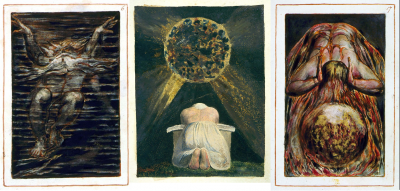The William Blake Cycle: Unseen, Unbodièd, Unknown
Friday 8th Sep, 2023

Lippes Concert Hall
105 Slee Hall Buffalo, NY 14260The William Blake Cycle: Unseen, Unbodièd, Unknown
by Tiffany M. Skidmore
A multimedia saxophone opera for 5 saxophones (one player) with chamber ensemble, spatial audio, video, and theatrical direction
Duration: 60 minutes
Cost: $10
Soloist Kyle Hutchins, saxophone
with
Dalia Chin, flute
Rebeccah Parker Downs, cello
Sheldon Johnson, saxophone
Katherine Kennedy, soprano
Jeffrey Siegfried, saxophone
Derek Shapiro, conductor
Justin Anthony Spenner, baritone
Annie Stevens, percussion
Shannon Wettstein, piano
Tiffany M. Skidmore, video and electronics
Ted Moore, Technical Director
Amanda Nelson, Theatrical Director
Artem Bank, Documentation
The Book of Ahania for bass flute and baritone saxophone
The Night of Enitharmon's Joy for flute, tenor saxophone, and electronics
Vala/Luvah for saxophone trio and electronics
Tharmas the father/Enion the mother for solo sopranino saxophone
The Spectre of Urthona for two soprano saxophones, cello, piano, percussion, and electronics
The Book of Ahania for bass flute and baritone saxophone
The Book of Urizen for alto saxophone and piano
Text and Images by William Blake
Adaptation by Tiffany M. Skidmore
Since 2015, composer Tiffany M. Skidmore and saxophonist Kyle Hutchins have been collaborating on a cycle of electroacoustic instrumental chamber pieces centered around the saxophone that considers text and characters created by William Blake. Each movement explores relationships between mythological characters in the Blake universe, nonbinary gender identity, sexual politics, and gender stereotypes.
The Book of Ahania acts as a refrain throughout the cycle. Ahania, the female emanation of Urizen, is his soul. Urizen becomes jealous and ashamed of his own feminine emanation–he sees her as “sinful” and hides her away until she becomes an unembodied shadow that wanders the earth, becoming “the mother of Pestilence.”
The focus of Blake’s characterization of the first female, Enitharmon, represents “female domination and sexual restraints that limit the artistic imagination.” The Night of Enitharmon’s Joy reinterprets Blake’s poem, conceiving of it as a commentary on sexual oppression/suppression using restrictive pitch/rhythmic materials. Musically, the foundational vocal melody can never develop. Live instrumental lines begin to sprout from above and below the foundation, always forced to loop back due to musical constraints. Electronic snippets of a romantic underlying melody and poetic text emerge periodically from the textures, while a prolonged electronic whisper eventually envelops all other musical elements.
In Vala/Luvah, Vala and Luvah are feminine and masculine emanations of a single entity. Vala/Luvah loves and hates him/her/themself with a fiery, apocalyptic intensity.
Tharmas the father/Enion the mother explores Tharmas’s masculine persona at multiple simultaneous “ages” — he is both a bearded old man and a young man with wings. At the same time, the ecstatic, wailing music of Enion, this being’s feminine persona, gradually fades away, disappearing over the course of the piece.
The Spectre of Urthona depicts the erotic encounter that gives birth to a world full of lush flowers and poisonous fruit.
The Book of Urizen is focused on the character Urizen, who features prominently in Blake’s Europe: A Prophecy. In Blake’s universe, Urizen represents the first living entity. He is intensely destructive, yet simultaneously “the embodiment of conventional reason and law." This piece explores Urizen’s multifaceted character and story through a complex, wordless setting of passages from Blake’s poem.
